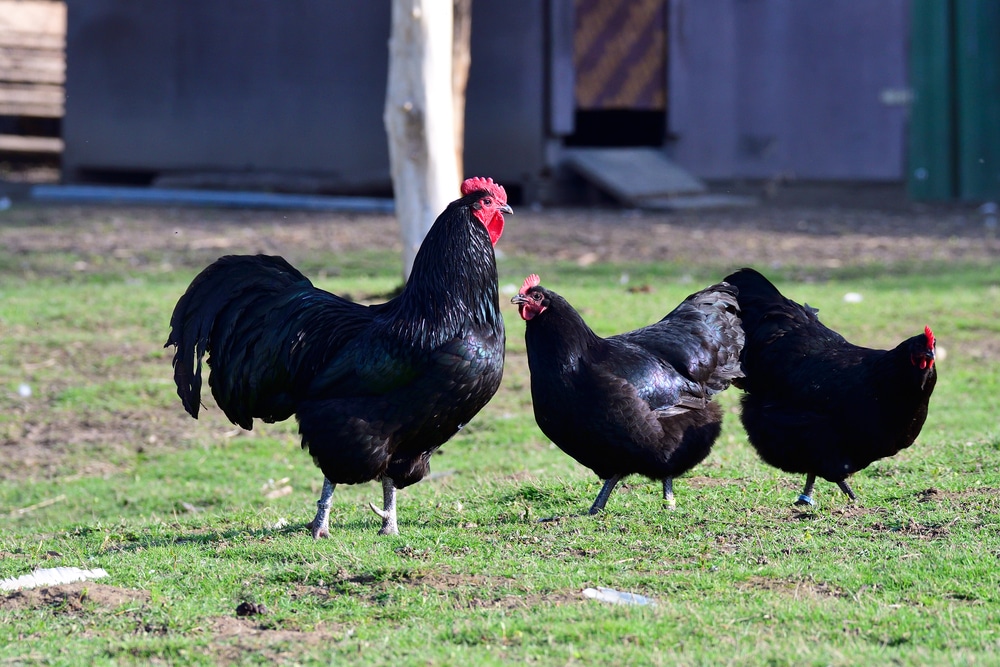The Australorp may not be the oldest chicken breed out there, and truth be told, its name sounds like something out of a science fiction movie!
However, this unique chicken breed has made a major impact during its so-far brief time on this world, and it’s taking the poultry world by storm.
If you haven’t yet considered raising this illustrious breed, now is the time to do so. Here’s everything you need to know about Australorp chickens.
Australorp Chicken Appearance
While there are several color variations of the Australorp chicken available, the American Poultry Association only recognizes the original color of the bird – black.
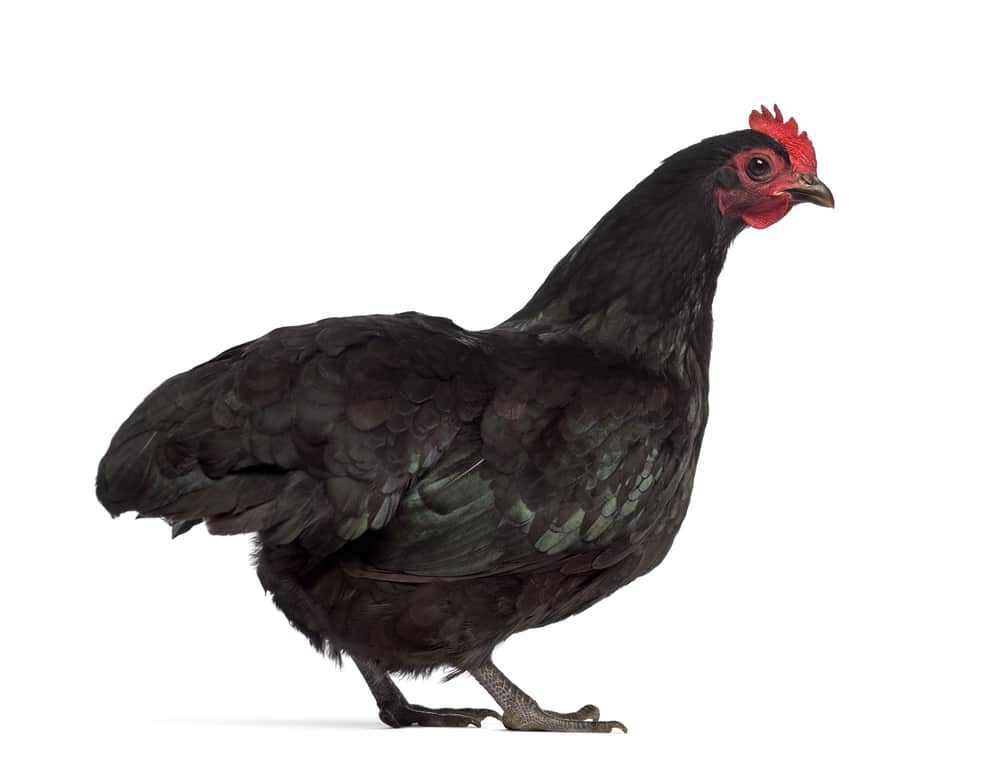
In Australia, however, the Australian Poultry Society acknowledges the blue, black, and white variants, while South Africa recognizes splash, buff, golden, and even wheat laced, too.
The black Australorp is, of course, the most common color variety of this chicken breed. It’s quite remarkable to behold. In the sunlight, the chicken will have a beetle-green sheen, making it appear iridescent when you view it outdoors.
The blue Australrop has blue-gray feathers that have small amounts of lacing. There are other varieties of Australorps that aren’t formally recognized because of breeding practices. However, one other unique color you might see is the “splash” variety. This one is a light grey-white in color with occasional sprinkles of blue.
This unique color is created by crossing two blue Australorps, but it’s not recognized because crossing these two colors doesn’t always result in the splash coloration.
Regardless of the color, the Australorp will be a large, heavyset bird with soft, close-fitting feathers. It has an upright posture, holding its tail high with a full, well-rounded breast. It has red combs, earlobes, and wattles. The comb is upright with no more than seven individual points.
Legs can be either slate blue or black, but will always be free from feathers. The chicken has four toes on each foot, with the skin on the very bottom of the foot just as white as the skin on the rest of the body.
One of the most unique features of the Australorp is that it has jet-black eyes. It also has a dark-colored beak, giving it a dreamy, mysterious appearance. Pair this with the stately demeanor of the chicken as it walks, and you’ll have quite the elegant bird! In fact, the Orpington chicken, one of the Australorp’s parent breeds, was named for this trait, as it looks much like a duchess at a tea party.
A standard-sized chicken, the Australorp is heavy, with males weighing up to ten pounds when mature and hens tipping the scales at roughly eight pounds. There’s also a bantam variety of this chicken breed, although it is less common. Males will be close to three pounds while females will be right around two.
Australorp Chicken Behavior
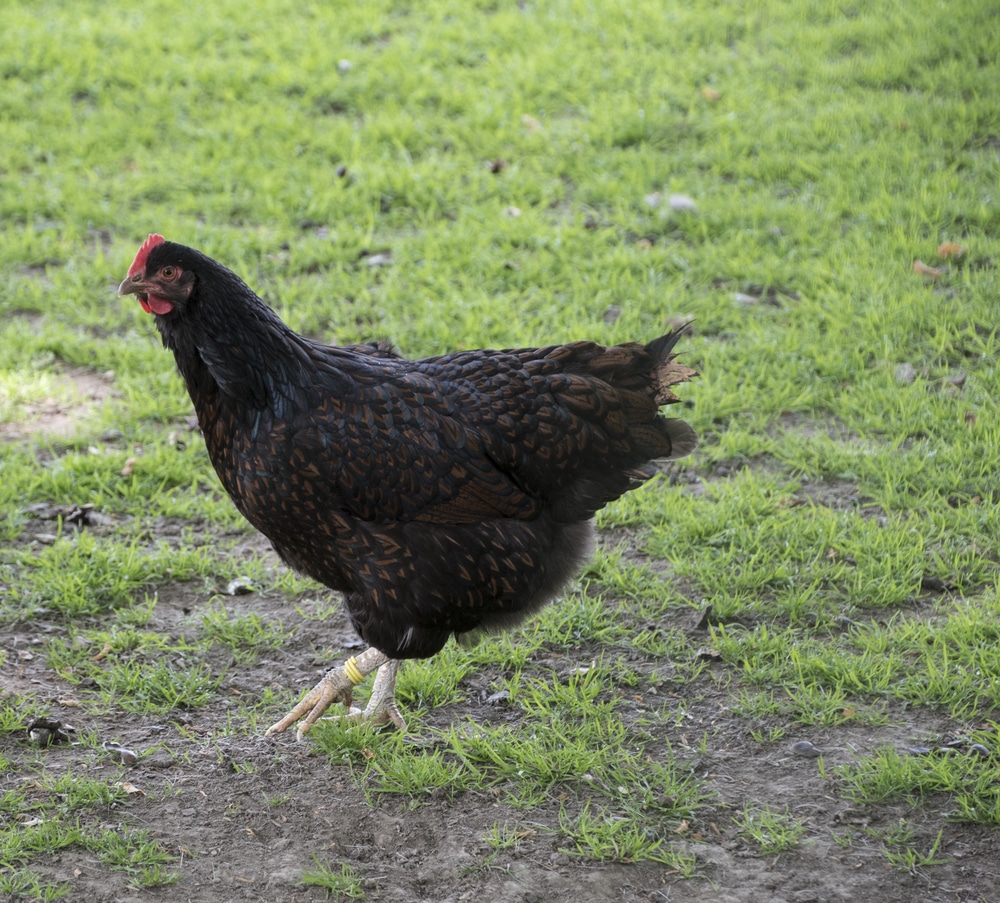
Australorp chickens are known for their graceful, peaceful demeanor. They are stately and poised as they move about the chicken yard, and can tolerate both confinement and free-ranging well.
These chickens like to be active, and exercise is good for them since they are so large. Like many heavy breeds, the Australorp is prone to obesity if it is kept exclusively in confinement. Thereof, it is important that you provide your chickens with plenty of access to free-ranging opportunities so they can scratch and peck for bugs and other tasty morsels.
The Australorp is a quick-growing breed. When you first bring your birds home, you may find that they have somewhat shy personalities. However, this fades quickly as they become accustomed to your presence. Once they’re used to you, you’ll find that they follow you all around the yard in the hopes of scrounging up a treat!
Australorp chickens are usually found smack dab in the middle of the pecking order. Despite their size, Australorps are not known for being pushy or aggressive and instead or quite calm and quiet. However, keep in mind that there is a tendency for this gentle giant to be bullied by other more dominant hens.
Egg & Meat Production of the Australorp Chicken
In this section we discuss the level of egg & meat production that you can ecpect out of Australorp chickens.
Is the Australorp Chicken Good for Eggs?
As you may have gathered in the introduction to the history of the Australorp chicken breed, it is one of the very best chicken breeds you can raise for eggs. Though not as prolific as commercial egg-laying breeds, like White Leghorns, the Australorp can provide up to 250 eggs each year.
This is dependent on the individual, of course, with some hens laying more or fewer eggs depending on their disposition.
Either way, the eggs will be light brown and medium-sized. A typical hen will provide around five eggs each year. If you raise Australorps in a highly controlled environment, such as the one you might find in a commercial set-up, you’ll find that they can be even more productive. This requires strict control of feed and lighting, however.
Egg production for the Australorp chicken rarely drops off. These chickens start laying eggs at 24 to 28 weeks of age and are known for their excellent laying ability. In fact, they’ll continue laying eggs during the winter months and production generally only drops when the birds are ill or are going through their annual molting cycle.
Is the Australorp Chicken Good for Meat?
Australorp chickens gain weight a bit more slowly than other chicken breeds, but you can still raise them to put meat on the table. If you are able to provide your Australorps with access to fresh pasture, you’ll notice that your feed bills are lower and your feed conversion rates are much improved.
On average, an Australorp will take about seven months to reach its full weight. Many people butcher before this to ensure that the meat is tender and more flavorful. However, if you want that large carcass, you can easily wait seven months to butcher your chickens.
The average hen or rooster will tip the scales at eight or nine pounds, so you’ll have a decent-sized carcass for the dinner table. The birds are known for their tender and slightly sweet white meat.
Common Problems & Issues
The Australorp chicken is a robust, healthy chicken with very few health problems to note. You won’t have to do anything out of the ordinary to care for this chicken, which can live up to ten years with proper care.
However, you will need to keep an eye out for problems like parasites, which can appear even on the healthiest chickens. Since the Australorp chicken has dense feathering, it is more prone to these sorts of problems. You can prevent external and internal parasites by grooming and inspecting your chickens’ feathers regularly.
Also, consider adding a dust bath to the coop. This is not only good to encourage positive social behaviors, but it will also help to keep parasites at bay. You can also feed your chickens natural deworming agents, like garlic or apple cider vinegar, to prevent parasites.
Australorps are quite heavy, so you don’t usually have to worry about them flying out of the pen. They aren’t known for being flighty, so it won’t be necessary for you to provide extra confinement measures or to clip their wings to prevent them from getting out.
Australorps withstand cold winter temperatures with ease, despite their origins in one of the warmest climates in the world. They are heavy enough and densely-feathered so that they can hold up well to extreme conditions. They continue to lie even when the temperature swings to being either extremely hot or extremely cold.
When you are adding new Australorp chickens to your flock, a good rule of thumb is to quarantine the bird for up to 31 days. This will give you time to make sure your chickens do not have any diseases that could spread to your existing flock. These chickens are sociable birds, but remember to introduce them slowly and with a watchful eye – you want to make sure they acclimate well.
Raising Australorp Chickens
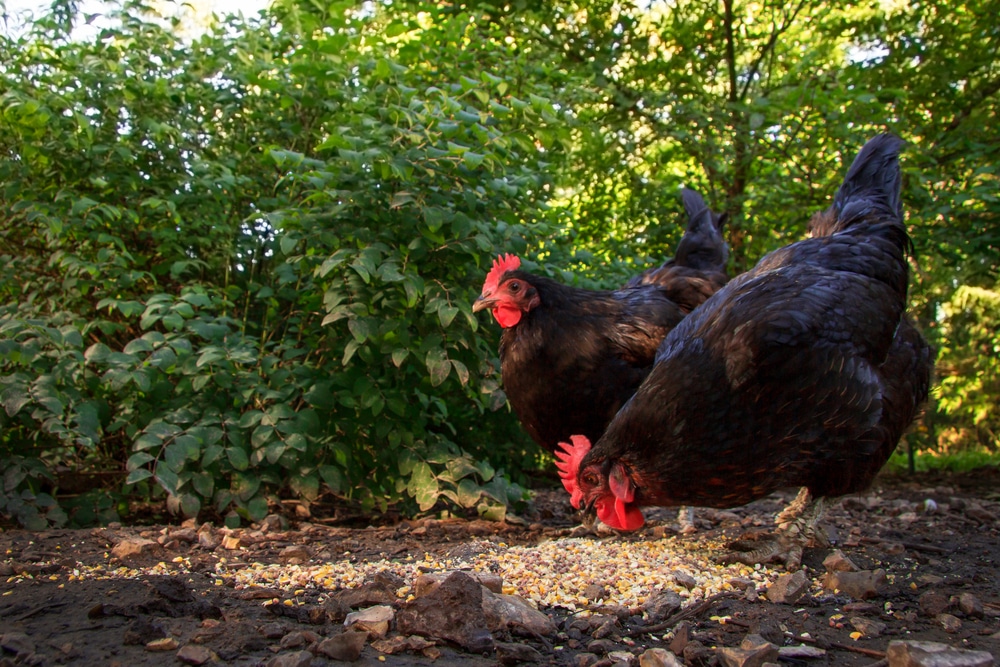
You can raise an Australrop chicken just about anywhere you live. Just make sure you have about four square feet per chicken in the coop and ten in the run. You will also need to provide plenty of room for the nesting boxes and roosting bars. Although these chickens handle confinement well, their size means that you will need to provide extra space.
Make sure you have decent ventilation in the coop but ensure that it’s not too drafty. Ventilation can be a God-send both in the summer and winter, as it will prevent smells and moisture build-up, but too many drafts can chill your birds during the winter. Ideally, your coop should be positioned up and off the ground so that the birds have a dry place to roost in the wet weather.
Installing a covered run is a good idea to keep your Australorps safe from predators. Although they can fly, they can’t fly terribly high, so it’s up to you whether you want to cover your run. Covering the run would really only be for the protection of your Australorps, as they might have a difficult time running away from airborne predators due to their size.
You won’t need to worry about any special maintenance or care instructions when raising your Australorps, either. Just make sure they have access to plenty of clean, fresh food and water. A layer feed is best if you are raising AUstralorps primarily for eggs, but you could also supplement this with a broiler feed instead.
Keep your Australorps in groups! While these chickens can do fine in flocks with other breeds of chickens, they’ll enjoy socializing with chickens that look just like them, too.
Benefits & Drawbacks of the Breed
Here are a few pros and cons of Australorp chickens:
Benefits
One of the biggest benefits of raising the Australorp chicken is that it is a dual-purpose breed. These chickens are excellent at producing both eggs and meat!
As a corollary to that point, Australorp hens are also fantastic mothers. They not only occasionally go broody, but they are also good mothers to their chicks when the eggs finally hatch. This is unique from their parent bird, Orpington, who is not known for being a good brooder.
They’re also known for being good foster moms. You can easily place eggs from other hens beneath your Australorp, and she will sit on them for you. However, just keep in mind that if you are breeding your Australorps as show birds, you will want to make sure you select the right bloodlines.
Easy to care for and producing an abundance of eggs, the Australorp chicken is friendly and lovable. These chickens are sweet and gentle and don’t bully your other hens. As a result, the Australorp is a great candidate for exhibition and for farm programs. It adjusts well to noise and is so beautiful that it often brings home blue ribbons.
Australorp are good foragers, and are sure to keep the weeds and insects out of your lawn! In fact, there is nothing these chickens love more than foraging and scratching in the garden.
Australorp chickens are also tolerant of a wide array of temperatures and climates. They can handle hot weather, such as you might find in Australia, as well as cooler areas like the American midwest. It’s truly an all-around fantastic chicken breed for you to raise!
Drawbacks
There are very few issues related to raising Australorp chickens.
However, keep in mind that it can sometimes be difficult to find in the United State, especially if you are looking for a color beyond black. It’s important that you only invest in chickens from registered breeding stock to make sure you are getting what you paid for, too.
Some chicken keepers claim that Australorp chickens are aggressive toward children or other animals. However, this is usually only true of roosters and has a lot to do with the individual temperament of the bird. It’s not something you will find in all Australrop chickens for sure.
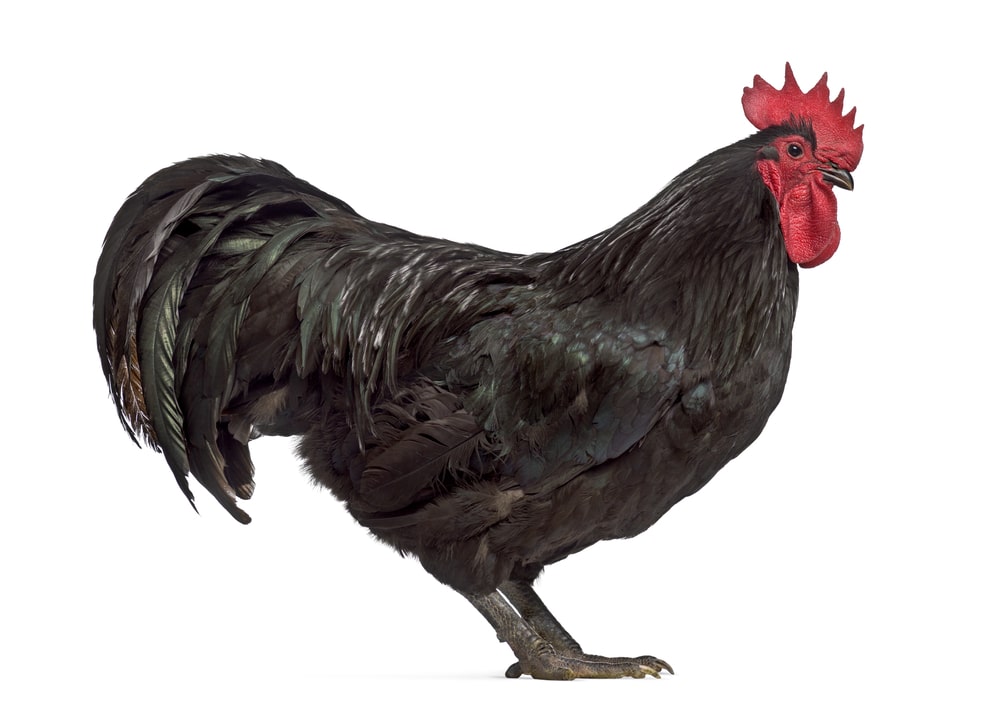
History of the Australorp Chicken
A contraction of the name “Australian Black Orpington,” the Australorp has been called numerous names throughout its storied history. Established in Australia, this chicken is considered the country’s honorary national bird.
The history is short, given how new these chickens are to the trade. In the early part of the 20th century, William Cook’s Orpingtons were brought to Australia, with the ultimate goal of developing a productive dual-purpose chicken that was also suitable for the harsh Australian climate. The Orpington was crossed with a Rhode Island Red, with curious settlers hoping that the cross would result in superior egg-laying ability.
It worked!
The next goal was to refine the bird in the hopes that doing so would result in superior meat quality. However, this was difficult in other areas, like England, as Australian breeders could not agree on whether meat or egg production was more important.
A flurry of experiment occurred for several years, with Orpingtons being crossed with all kinds of breeds, including Rhode Island Reds, White Leghorns, Plymouth Rocks, Langshans, and even Minorcas.
Eventually, one combination rose to the top. Nobody can say for sure which one won, but it is likely that the combination of the Leghorn, Orpington, and Rhode Island Red reigned supreme.
The proof that finally won over the breeders? In the years 1922 to 1923, a small flock of just six Australorp hens laid 1,857 eggs – or more than 309 eggs per bird over just 365 days. Later, egg-laying contests further solidified the Australorp’s place as one of the best dual-purpose breeds.
One bird broke the record laying 364 eggs in 365 days. This is a pretty impressive achievement, especially when you consider that no supplemental lighting was used to encourage laying during the off periods.
After this record was shattered, the global poultry industry took serious notice. This prolific layer was a bird that didn’t have to be forced to lay eggs – it just did it naturally! Later, the Australorp was crossed with the White Leghorn, producing an even more productive bird known as the Austra White.
For several decades following the development of the Australorp, interest waned as commercial poultry farms switched to single breed productions (for the most part, only utilizing White Leghorns for their laying operations).
Luckily, as more people gain interest in raising heritage breed chickens, there is a renewed interest in unique breeds like the Australorp. Today, it is listed as a recovering breed and is not only a top layer, but is one of the best backyard chicken breeds you can raise.
The chicken is known by many names today, including the Australian Orpington, Austral, and the Black Australorp (although there are white and blue variants offered, too).
Is the Australorp Chicken Right for Me?
The Australorp chicken is sure to become the standout in your flock of backyard birds. A friendly, easygoing chicken, it’s perfect for beginners since it doesn’t require a lot of special care. It’s also easy to deal with and acclimates well.
Whether you are raising a flock entirely of Australorps or you want to raise a flock of mixed breeds, this chicken is a great choice for you. It isn’t flighty or loud and will produce a ton of delicious eggs (and even some meat!) for you, too.
What more could you possibly want? Consider raising an Australorp chicken – you won’t regret it.
